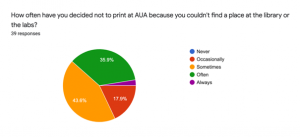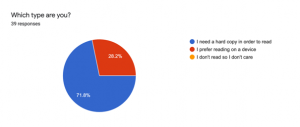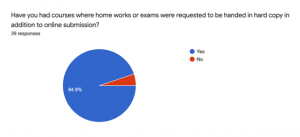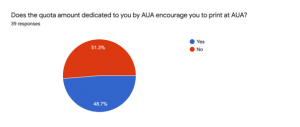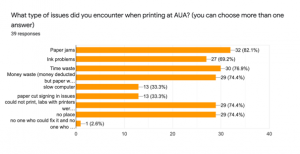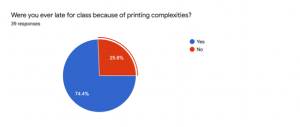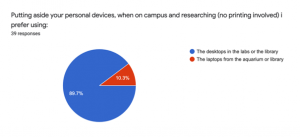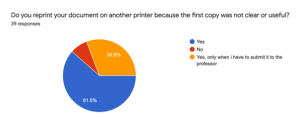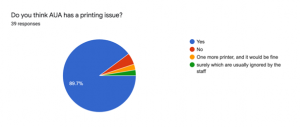
To Print or Not To Print? That is the Question AUA Students Deal With Every Day.
Author: Roubina Seropian
Abstract:
The growing number in students are challenging the printing facilities and their managements, leading to dissatisfied students. The main problems tackled are the imbalance between the quantity of printers versus the students demands, the over crowdedness of the labs and unavailability for quick printing jobs, mandatory printed assignments and printing quotas for each registered student. The paper suggests five recommendations to the university’s administration consisting of purchase of a new high capacity printer and new laptops to accommodate the needs of the students. In return elimination of printed assignments, prohibition of using computer labs with printers for conducting classes or tests and lastly the assignment of proctors in each facility responsible for the printers. These recommendations if considered would ease the problems facing the students and the university administration.
- Introduction:
The leading university in Armenia struggles with printing issues on campus, leaving its students dissatisfied and frustrated. There are four printers at the disposition of 1800 students, out of which only two were running since the beginning of the spring semester 2020. The mismanagement of the printing facilities at the American University of Armenia (AUA) has become one of the leading issues discussed within students and a headache for the university management. Short term attempts have been taken by the university management; such as repairing of printers and setting a maximum page quota per printing job but these solutions have not eliminated the core problem. The failure in finding a definite solution for the ongoing problem, especially since the number of students increase on a yearly basis, give rise to questioning the capabilities of the prestigious university’s abilities in managing its printing glitches.
This paper addresses the problems that are contributing to the dissatisfaction of the students in printing at the university consequently suggests recommendations for improvements. For this purpose, primary data has been collected through a survey shared by mail with 47 PSIA students, an online questionnaire has been sent to AUA’s ICTS director for some data concerning repairs, ink and paper usage and an online questioning to a Harvard student concerning his experience with printing on campus. Also, some secondary research has been done through checking the policies for printing at two leading universities in the US such as Harvard and Stanford. It is acknowledged that 39 students do not represent the overall students’ dissatisfaction with the printing at AUA but having in mind that the university has been locked down since March, following up with students, conducting focus groups and interviews were not an option to gather more opinions of students. But concerning that the PSIA students amount to 47 the 39 respondents amount to 83% of the cohorts, therefore considered a majority.
This research has identified four main problems for the ineffective printing at AUA which will be addressed in the paper after which solutions will be recommended to the administration of the university.
- Quantity of printers versus number of students
- Over crowdedness of labs and unavailability for quick printing jobs
- Mandatory printed assignments
- Printing quotas
- Problem description:
Since the opening of the undergraduate programs in 2013 and with the growing numbers of students and programs, the American University of Armenia has been having issues concerning the printing facilities and printing jobs, leaving its students dissatisfied and critical about the abilities of the university to adjust with the changes. Four main problems are in need of the administration’s attention; the quantity of printers at the disposal of the growing number of students, the over crowdedness of the printing facilities and unavailability for students quick printing needs, mandatory printed assignments and printing quotas for students.
2.1 Quantity of printers versus number of students
Due to the growing numbers of students throughout the years, and since the amount of reading materials at AUA is above average compared to other universities in Armenia, students print out much of their readings for homework. On average a student’s reading material at AUA would sum up to 40 pages for a course per week. A graduate student with four courses per semester would have around 2,400 pages to read without counting the required printed assignments. 72% of the respondents said that they need a hard copy in order for them to read their assignments, the remaining 28% prefer to read on their devices. 69% of the respondents faced ink problems where their printouts come out faded and unreadable leading to the 92% of the respondents reprinting of the same documents on another printer and dumping the first copy in the trash. The double printing is costing the students double the money and end up with paper waist, countering AUA’s green policy. The excess and non-stop usage of printers due to high demand lead to printer malfunctions such as paper jams experienced by 82% of the students interviewed. Students manually free the jam from the printer often, and when such cases happen the printer reprints the pages jammed therefore consume more paper.
A sub issue is encountered concerning the surveillance of the printing facilities and the availability of help from a lab proctor. The surveillance in the library is somehow more effective since the printers are situated right by the librarians’ counter where help is easily attained, but the problems do exist in the library as well. The situation differs in the computer labs 001 and 004. The lab 001 has no surveillance, students manage their needs on their own when issues arise, from pressing different buttons, opening doors to free jammed papers, to filling the printers up with papers and shaking the cartridge up and down to squeeze the last drop of ink, and eventually asking some other students in the room for help. Lab 004 has a part time proctor who helps students in need with printing issues when around and when he is not on duty students are left to deal with their problems on their own.
With time the university has added the number of printers to a total of four, yet students still face problems on a daily basis and that is due to the fact that four computers are not able to fulfill the needs of 1800 students. According to the ICTS director Berj Gatrjyan, during the last two years the printers have undergone four to five serious repairs and numerous preventive maintenances and repairs. Effectively the two years would amount to four semesters meaning within 16 months (1.3 years) of heavy usage the printers have had four to five major repairs where printers are sent out to be fixed, leaving students with less than four printers to use. Bringing in my own experience with the matter, in the 2019 fall semester the printer in lab 004 was sent for maintenance for more than three weeks because the print outs were tainted with black lines and dots leading to the unreadability of the document. Eventually, the printer was back without resolving the matter. Students were still dissatisfied with their stained copies, waisted money and left enormous amount of waste paper in the garbage bins. The printer was still there in the same situation up until the lockdown of the university in March.
When asked about the possibility of adding one more printer with bigger capacity for printing at AUA since to meet the needs of the students and reduce the load on the remaining printers, Mr. Gatrjyan replied that there is no intention in adding bigger capacity printers due to the AUA’s policy to reduce the usage of paper and encourage students to use electronic resources. Although AUA’s green policy is encouraged, the reality of the matter shows that due to malfunctioning of the printers AUA does not meet the objective of its green policy on the contrary it is becoming a pressing issue on paper waste.
It is to mention that a copy center is available on the sixth floor of the main building, which is not used by students as much. It is an extra hassle to rushing students since the center is situated on the sixth floor of the main building, it is operated by a not so computer savvy lady and is mainly used for an emergency last minute colored printing urgency, usually done in printing houses outside the university because it is cheaper. But the copy center is not in the scope of this study since it is irrelevant to the students’ need and satisfaction.
2.2 Over crowdedness of labs and unavailability for quick printing jobs
Frustrations of students not finding space at the campus library or computer labs to print their readings and assignments have been expressed with critical discussions between students and considered a hopeless case not even worth voicing their irritations. 74% of the students questioned said that not finding a place in the labs or library as one of the pressing issues at AUA. Adding to this, another 74% of the respondents faced the problem of not being able to use the labs with the printers due to an ongoing class or exam at those facilities. It is worth mentioning that there are four computer labs on the ground floor of the main building out of which two have printers (001 and 004). The majority of the time exams are held in the labs with the printers instead of the ones without, leading to the unavailability of the printers for students with printing needs.
The labs and library desktops are used by student for different educational purposes, some barge in for a 15minute printing job, others use the computers for assignments and research. To adjust to the growing need of studying space, AUA has created a space called the aquarium on the ground floor of the main building, right across the library. Although there are no desktops in this area, students with personal laptops can work at the facility and others can borrow AUA laptops from the proctor in the aquarium. Although this is a great incentive to add up more working space for students and to try to ease the pressure from the labs and library, the initiative is left halfway from reaching its effective purpose. The laptops at the students disposal are so old, slow and work only with the charging cables on. Once the cable falls off, the computer shuts down and takes about 10 minutes to restart. The library offers a batch of the same laptops as well to use in the library. When the students were asked about their preference in choosing the AUA desktops or laptops, about 90% percent answered they preferred to work on the desktops rather than the laptops offered by AUA. Therefore, the laptops offered are not effective for student’s usage and students seem to avoid using them rather chose to wait for a desktop to be freed in order work or print, since these dinosaur aged laptops do not even have the papercut application for printing to tempt the students with printing needs. This leads to the crowdedness of the facilities and the decrease in probability of finding a free computer to print a document that would only require a minimum of five to a maximum fifteen minutes print time.
2.3 Mandatory printed assignments
Although AUA strives to remain an environmentally friendly university, it’s green policy on paper usage is not adequately implemented. 95% of the students had courses where mandatory print outs were required for Homework or assignments, in addition to online submission. What is more, out of the 92% who reprint their documents, if the first copy was not usable due to malfunctioning of the printer, 31% reprint only when they are asked to hand in a hard copy of an assignment. These mandatory print outs encourage printing and mandate the students to go through the painful experience of printing, waiting for free computers, making sure the printer is loaded with paper and ink, praying that there are no queues of printing jobs before their documents turn at the chosen printer and lastly no paper jam will slow down the process. 74% of the respondents had instances of being late to class because of printing complexities.
To try to regulate the long wait time for a printing job, AUA has set a policy of printing up to 20 pages maximum per printing job. For example, if a student with 40 pages of printing job would have to split the reading in half in order to meet the 20 pages limit per printing job. This would give a split second’s chance for another person’s job to be queued for printing before the second batch of the 40 pages is sent for queuing. This is helpful for inexperienced student who take their time in sending printing orders one at a time, but after a while students understand that they can send in their X amount of 20 pages to papercut and simultaneously press all the printing jobs in a split second therefore keeping the printer busy for themselves while others wait until the X amount of 20’s are printed.
2.4 Printing quotas
AUA collects 25, 000AMD for services and fees from students on a yearly basis. Out of which a quota of 3,750 AMD is allocated to students for printing purposes (AUA ICTS, 2020). I claimed that this allocation encourages students to use the money granted for printing even when not necessary due to the fact that if the quota is not used the remaining balance is not carried to the coming year nor refunded, leading to the loss of that amount. To my surprise 51% of the students said that the quota does not encourage them to print. This could be due to the fact that students have a lot of printing to do since 72% prefer reading on a hard copy, hence the limit is surpassed within a short time, therefore students have to refill on their own expense and continue printing anyways.
To conclude, it is obvious that AUA is struggling with printing dissatisfaction on campus, there is the need for effective solutions to overcome the issue especially that the number of students keep rising from year to year. 95% of the respondents think that AUA has printing issues. One person elaborated that there is surely an issue with printing and that is ignored by the staff and another suggested that there is a need for one more printer “to make things fine”. The effective management of the printing facilities would firstly show the university’s stance towards its students’ satisfaction, it would try to meet its green policy objectives and simply be a model of effectiveness and show the university’s capabilities in handling crisis situations. Unfortunately, AUA has been struggling not only with printing issues, but also has not been able to find although a temporary effective solution for their parking and cafeteria crisis.
- Policy options
There are many possible ways to try to solve the mismanagement of the printing facilities at AUA. As it is discovered the majority of students prefer reading on paper rather than electronic devices. This clashes with the fact that AUA strives to be an ecofriendly university. The established quotas do not reflect the green objective of the university. Although students do not seem to be encouraged to print by the amount set for each, AUA has to eliminate the designation of quotas for printing purposes just to set the ethical background of their objective. Either way the quota granted is used from the 25,000 AMD student fees payed on a yearly basis. Those who prefer to read on paper get to decide how much to dedicate for their printing purposes. Same goes for the elimination of the printed assignments and the final students’ capstones do also back up the green policy objective and the student’s hassle to print and also avoid the stacking of these works on shelves.
Under the argument of environmentally friendly, the university is abstaining from adding one more printer under the disposal of its growing students. Unfortunately, the research showed that the over usage of the printers, are damaging and resulting in paper, money and time waste. The amount of printing is not diminishing rather doubling because of reprinting of needed documents. Therefore, there is the need for one more printer with bigger capacity than the already existing four printers. According to the Harvard student interviewed, there are enough printers to accommodate the students’ needs at Harvard Business School. I addition to the printers in the library, there are printers provided on each floor of the dorms students stay at. These printers accommodate about 20 to 30 students per floor. Although AUA students’ number cannot be compared to Harvard’s, but the fact that there are enough printers to accommodate the demand eliminates the over exhaustion of the printers and contains the needs of the students. The additional high capacity printer would cost AUA somewhere between 5,000 to 10,000 USD depending on the brand, features and capacity. Although this would be an extra cost but It would diminish the maintenance and repair expenses, lessen the amount of wasted paper and most importantly meet the needs of the students.
Another options would be to replace the old laptops with new up to date laptops worthy of AUA standards. The new laptops would firstly diminish the necessity of using the desktops for non-printing needs, such as research, reading Homework and preparing of assignments. With this step the probability of finding desktops for printing purposes would be higher. Stanford has set up a system of computers available for students and faculty which visitors are not allowed to use called “cluster computers” and “kiosk computers” are at the disposal of its visitors (Stanford Libraries, n.d.)
The option to download the papercut application for printing on these new AUA laptops and also on student’s private laptops could be considered. Although this would facilitate the printing hassle, the downsides to this easy option would be a leeway for more printing. This method is used by Harvard, wireless printing through papercut has been enabled for faculty and students (Harvard University , 2020).
Lastly AUA can outsource its printing problems. In order to avoid the hassle and expenses of keeping printing facilities, and the dilemma between being ecofriendly and encouraging printing, AUA could rent out a space for a private businesses to manage the printing at AUA, just like it does with its cafeteria. Although this might seem tempting to the administration to free it shackles from the printing crisis, the mismanagement of the private business could also lead to dissatisfaction, just like in the case of the cafeteria, which might lead to finding new businesses after contracts are due. Another issue could be finding the right spot within the campus to accommodate the needs of the printing center.
- Recommendations
My recommendations are targeted towards the university’s administration, who make up the decisions and rules that will be followed by the rest. These recommendations would benefit the university over all, leaving students satisfied with printing and hopefully will reduce the pressure and expenses on the administration.
First, by eliminating the printing quotas and mandatory printed assignments and capstones, the university would first stick to its green policy and second would eliminate the burden of printing on students.
The second recommendation would be to update the laptops which would lessen the demands on the desktops, leaving the labs and library less crowded.
Third, do not reserve the labs with printers, 001 and 004 for class or testing use. Rather use the labs 002 and 003 for such cases. The reservation of the new laptops could also be allowed to use for such cases on the request and supervision of the instructors.
Fourthly, the addition of one more printer with higher capacity of printing which will replace the printer in lab 004 which was not repaired efficiently and balance the demand.
Lastly, eligible proctors should be assigned to monitor the printers and control the ink and paper replenishments and take care of malfunctioning when occurred. Usually this is done under the tuition assistance policy, therefore there are no extra costs attached.
Three out of five recommendations are management-based decisions that can be acquired without extra costs on the university. The major expense would be in buying the new printer and the laptops. The printer is a necessity, since the one in lab 004 is not usable because it was not fully recovered after three weeks of repair. Keeping the printer in lab 004 would be misleading students into printing tainted documents that would lead to the loss of their money and reprinting of the document, both ethically wrong. The new printer must be equal to the capacity of two printers. The laptops could be purchased on stages and gradually to accommodate the university’s budget.
- Conclusion
This paper tackled the issue mismanagement of the printing facilities at AUA and has come up with some recommendations to the university’s management.
The growing numbers in students at the university tag along more demands and amenities. The facilities of the university make up a great deal of students’ satisfaction and it is expected of the leading university in Armenia to accommodate its students with the best quality of education and experience throughout their academic journey. One of the most established targets at AUA is to enhance the critical thinking abilities of its students, a two-edged sword. The university is not immune of its students’ criticism; hence it is crucial for AUA to keep its image and reputation as high as its standards in the eyes of its students and faculty first which in return does reflect to the public.
Appendix A
Works Cited
- AUA ICTS. (2020). Printing on Campus. Retrieved from AUA Information & Communication Technologies Services: https://icts.aua.am/student-printing/
- Harvard University. (2020). Computers & Printing. Retrieved from Center for Public Service & Engaged Scholarship: https://publicservice.fas.harvard.edu/computers-printing
- Stanford Libraries. (n.d.). Computers and Printing. Retrieved from Robin Li and Melissa Ma Science Library: https://library.stanford.edu/science/using-library/computers-and-printing

